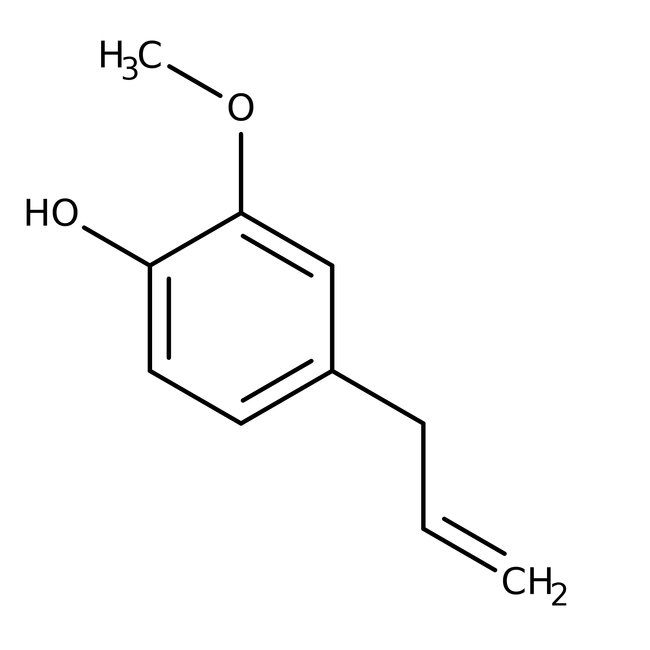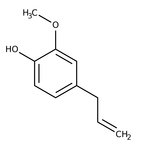Search Thermo Fisher Scientific
Thermo Scientific Chemicals
Eugenol, 99%
CAS: 97-53-0 | C10H12O2 | 164.20 g/mol
| Catalog Number | Quantity |
|---|---|
| ALFA14332.22 | 100 g |
Catalog number ALFA14332.22
View Price:Sign InSign in to see your account pricing. Need an account? Register with us today.
Quantity:
100 g
Specifications
Chemical Name or MaterialEugenol
CAS97-53-0
Health Hazard 1H302-H315-H317-H319
Health Hazard 2GHS H Statement
H302-H315-H319-H317
Harmful if swallowed.
Causes skin irritation.
Causes serious eye irritation.
May cause an allergic skin reaction.
H302-H315-H319-H317
Harmful if swallowed.
Causes skin irritation.
Causes serious eye irritation.
May cause an allergic skin reaction.
Health Hazard 3P261-P264b-P270-P272-P280-P301+P312-P302+P352-P305+P351+P338-P330-P333+P313-P362-P501c
View more
Internal standard in GC assays for presence of thymol in biological samplesEugenol is used in cosmetics, essential oil, perfumeries and flavorings. It finds application as a local antiseptic and anesthetic. It is combined with zinc oxide to form zinc oxide eugenol, which is used in dental restoration especially for root canal sealing and prosthodontics. It is also an antifungal antimicrobial agonist of the TRPV1 receptor. It is also used in production of stabilizers and antioxidants for plastics and rubbers. Further, it is used in the production of vanillin. It serves as an active ingredient in cloves. In addition to this, it is used as an insect attractant, chemical intermediate and denaturant for alcohol.
This Thermo Scientific Chemicals brand product was originally part of the Alfa Aesar product portfolio. Some documentation and label information may refer to the legacy brand. The original Alfa Aesar product / item code or SKU reference has not changed as a part of the brand transition to Thermo Scientific Chemicals.
Applications
Internal standard in GC assays for presence of thymol in biological samplesEugenol is used in cosmetics, essential oil, perfumeries and flavorings. It finds application as a local antiseptic and anesthetic. It is combined with zinc oxide to form zinc oxide eugenol, which is used in dental restoration especially for root canal sealing and prosthodontics. It is also an antifungal antimicrobial agonist of the TRPV1 receptor. It is also used in production of stabilizers and antioxidants for plastics and rubbers. Further, it is used in the production of vanillin. It serves as an active ingredient in cloves. In addition to this, it is used as an insect attractant, chemical intermediate and denaturant for alcohol.
Solubility
Miscible with ethanol, ether, oils, alcohol, glacial acetic acid, chloroform and aqueous sodium hydroxide. Immiscible with water.
Notes
Air sensitive. Incompatible with strong oxidizing agents.
Internal standard in GC assays for presence of thymol in biological samplesEugenol is used in cosmetics, essential oil, perfumeries and flavorings. It finds application as a local antiseptic and anesthetic. It is combined with zinc oxide to form zinc oxide eugenol, which is used in dental restoration especially for root canal sealing and prosthodontics. It is also an antifungal antimicrobial agonist of the TRPV1 receptor. It is also used in production of stabilizers and antioxidants for plastics and rubbers. Further, it is used in the production of vanillin. It serves as an active ingredient in cloves. In addition to this, it is used as an insect attractant, chemical intermediate and denaturant for alcohol.
Solubility
Miscible with ethanol, ether, oils, alcohol, glacial acetic acid, chloroform and aqueous sodium hydroxide. Immiscible with water.
Notes
Air sensitive. Incompatible with strong oxidizing agents.
RUO – Research Use Only
General References:
- Benchaar, C.; Hassanat, F.; Petit, H. V. Dose-response to eugenol supplementation to dairy cow diets: Methane production, N excretion, ruminal fermentation, nutrient digestibility, milk production, and milk fatty acid profile. Anim. Feed Sci. Technol. 2015, 209, 51-59.
- Jeong, K. H.; Lee, D. S.; Kim, S. R. Effects of eugenol on granule cell dispersion in a mouse model of temporal lobe epilepsy. Epilepsy Res. 2015, 115, 73-76.



